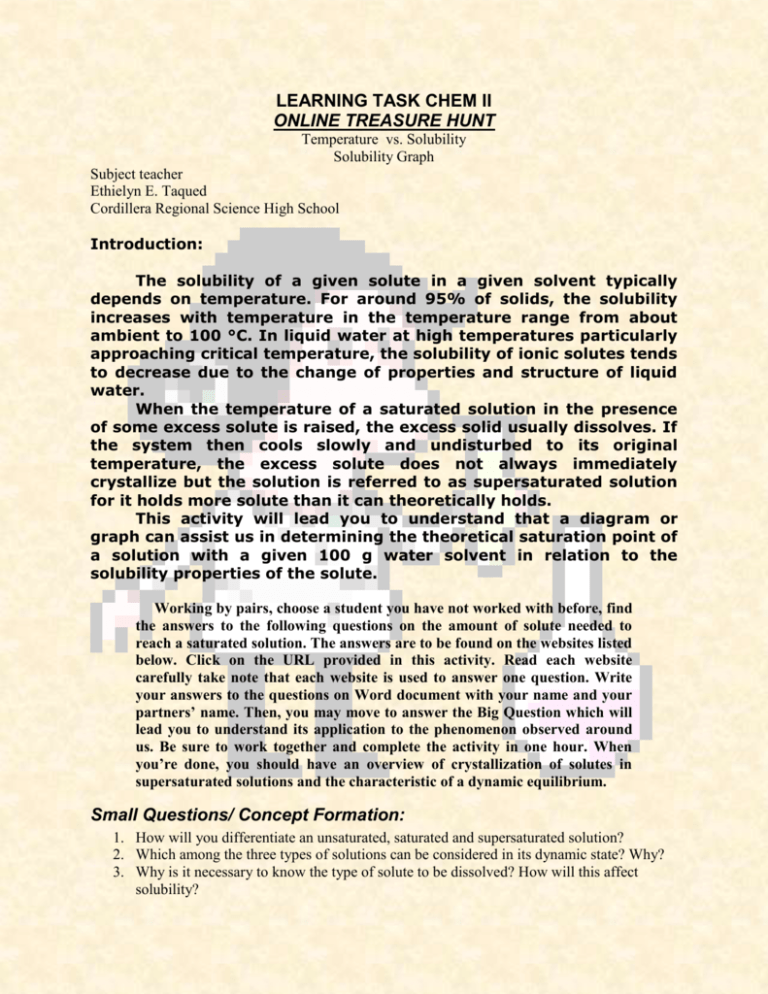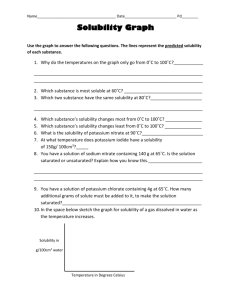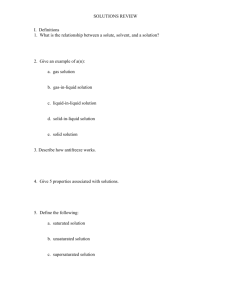SOLUBILITY GRAPH
advertisement

LEARNING TASK CHEM II ONLINE TREASURE HUNT Temperature vs. Solubility Solubility Graph Subject teacher Ethielyn E. Taqued Cordillera Regional Science High School Introduction: The solubility of a given solute in a given solvent typically depends on temperature. For around 95% of solids, the solubility increases with temperature in the temperature range from about ambient to 100 °C. In liquid water at high temperatures particularly approaching critical temperature, the solubility of ionic solutes tends to decrease due to the change of properties and structure of liquid water. When the temperature of a saturated solution in the presence of some excess solute is raised, the excess solid usually dissolves. If the system then cools slowly and undisturbed to its original temperature, the excess solute does not always immediately crystallize but the solution is referred to as supersaturated solution for it holds more solute than it can theoretically holds. This activity will lead you to understand that a diagram or graph can assist us in determining the theoretical saturation point of a solution with a given 100 g water solvent in relation to the solubility properties of the solute. Working by pairs, choose a student you have not worked with before, find the answers to the following questions on the amount of solute needed to reach a saturated solution. The answers are to be found on the websites listed below. Click on the URL provided in this activity. Read each website carefully take note that each website is used to answer one question. Write your answers to the questions on Word document with your name and your partners’ name. Then, you may move to answer the Big Question which will lead you to understand its application to the phenomenon observed around us. Be sure to work together and complete the activity in one hour. When you’re done, you should have an overview of crystallization of solutes in supersaturated solutions and the characteristic of a dynamic equilibrium. Small Questions/ Concept Formation: 1. How will you differentiate an unsaturated, saturated and supersaturated solution? 2. Which among the three types of solutions can be considered in its dynamic state? Why? 3. Why is it necessary to know the type of solute to be dissolved? How will this affect solubility? 4. What are the variables found in the graph? 5. What important information you can draw from a solubility diagram/ curve? Web Resources DYNAMIC EQUILIBRIUM http://en.wikipedia.org/wiki/Dynamic%5Fequilibrium SATURATED SOLUTION http://www.coolschool.ca/lor/CH12/unit3/U03L04.htm SOLUBILI TY GRAPH http://www.thesciencedesk.com/sgsolubilitygraph.htm MULTIPLE-CHOICE EXERCISE http://www.sciencegeek.net/Chemistry/taters/solubility.htm CONCEPT OF SOLUBILITY CURVE http://en.wikipedia.org/wiki/Solubility MINERAL FORMATION http://www.britannica.com/EBchecked/topic/383726/mineral-deposit/82171/Formation-ofmineral-deposits Big Question T TH HE EA AC CT TIIV VIIT TIIE ES S IIN NT TH HE EB BIIG GQ QU UE ES ST TIIO ON NS SA AR RE ED DIIV VIID DE ED D IIN NT TO OT TH HR RE EE E. Prepare an online presentation for discussion. For those groups with power point presentation must not go over 5 slides. Activity 1 For groups 1-4 Draw a graph to show the solubility of potassium nitrate, the figures are given below. The solubility goes up the side, the temperature goes along the bottom. Draw a smooth curve through the points on the graph: Temperature in oC 0 20 40 60 80 100 Solubility in g/100g water 13 32 64 110 169 246 Activity 2: For groups 5-8 Complete the table by filling in the difference column and answer the questions that follow. Name of chemical at solubility solubility difference at 15oC at 80oC Which is the least soluble at Copper (II) sulphate 18.8 55 Potassium chloride 32.8 51.3 Potassium nitrate 25.8 169 Sodium carbonate 16.4 45.8 sodium chloride 35.9 38.4 15oC? Which is most soluble 15oC? Which one is most soluble at 80oC? Which one increases in solubility by the most? Which one increases in solubility by the least Activity 3 For groups 9-12 How are mineral deposits formed around edges of hot springs? Your total working time is 30 minutes and 30 minutes for discussion…..Have a nice time looking for the Treasure…!!!!!





